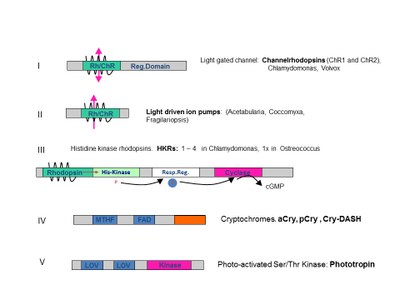Photobiology of microalgae and molecular characterization of the sensory photoreceptors controlling these processes.
Life on earth has developed under the rhythmic control of sunlight. The processes that are activated by light include developmental processes as well as processes that allow orientation in a complex colorful world, a process called “vision” in a very common sense.
Green algae are extremely rich in photoreceptors and an endless source of light sensors that may be applicable in other research fields.

Fig. 1: Different green algae: Chlamydomonas (1), Volvox (2), Euglena (3), Dunaliella (4), Acetabularia (5).
Some of these photoreceptors are widely distributed in nature as for example Chryptochromes whereas others as Channelrhodopsins are restricted to motile microalgae. During the recent years we have characterized photoreceptors of several different algae and a few from bacteria with a focus on those photoreceptors that are unusual and only scarcely characterized.

Fig. 2: Photoreceptors in green algae
However, our model organism still is the unicellular alga Chlamydomonas reinhardtii (Fig. 1) although most of our work is done in vitro with purified proteins. Our original question was how the alga orients itself in the light and, more specifically, how the algal eye is controlling flagellar beating.

Fig. 3: Flagellum
Chlamydomonas contains at least 9 different sensory photoreceptors including 1 phototropin, 3 chryptochromes, 2 channelrhodopsins, 4 Histidine Kinase rhodopsins. (Fig. 2)
Phototropin, a blue light receptor with two flavin-containing light sensitive photoreceptor modules (LOV-domains) and a Ser/Thr-Kinase effector domain. In Chlamydomonas phototropin regulates cell division and the size and sensitivity of the eye. Another main research topic in our group is the analysis of Channelrhodopsins (ChRs), which are light sensitive ion channels found so far only in motile microalgae. ChRs are the primary photoreceptors of the algal eye and used to guide the algae to places that are optimal for photosynthetic growth. They modulate the membrane voltage during helical swimming and the flagellar beating accordingly until the cell swims directly to or away from the light source. At sudden changes of the light brightness the ChRs evoke action potentials in the flagellar membrane followed by a sudden Ca2+ influx and a reversal of the flagellar beating resulting in a stop or shock response. Since 2005 Channelrhodopsins are employed as the most versatile optogenetic tools. In this conjunction they are incorporated in selected neurons of membrane slices or living animals, which then are activated by light to study their function.

Fig. 4: Systems neuroscientists are pushing aside their electrophysiology rigs to make room for the tools of 'optogenetics'. Lizzie Buchen reports from a field in the process of reinvention. Nature, May 2010.
This technology has been selected as the Method of the year 2010. https://www.youtube.com/watch?v=I64X7vHSHOE. We are modifying ChRs respective absorption spectra, kinetics, and ion selectivity to understand the mechanism but also to open new doors for wider or novel applications in neurosciences and cell biology.
Recently, a number of light-driven ion pumps that are widely distributed in bacteria were also discovered in algae. This was quite unexpected since algae use chlorophyll-dependent photosynthesis as land plants. It is still not clear why and for what purpose algae need energizing light-driven pumps. We characterized light driven pumps from Acetabularia and the arctic alga Coccomyxa subellipsoidea.
Another group of novel photoreceptors that is intensively studied in our group are rhodopsins that are assumed to be involved in light-dependent gene regulation (transcription). These are Histidine-Kinase-Rhodopsins (HKRs). In histidine kinase rhodopsins the rhodopsin unit is directly connected to a His-Kinase and a response regulator domain (RR) and in some cases to a c-terminal guanylate or adenylate cyclase enzyme unit (AC or GC). The rhodopsin units are extremely interesting due to their photochromic properties. This means they are activated by a certain color of light and inactivated by another light color. Thus the HKRs are sensing the ratio of different environmental light qualities for example UV light versus visible light “telling” the alga when the light conditions become dangerous. HKRs are more widely distributed in algae compared to channelrhodopsins but functional studies are still scarce.
To unravel the physiological photoreceptor function we invested quite some time and money to establish gene targeting by homologous recombination in green algae. A specific modification of photoreceptor genes is essential for a detailed understanding of the molecular and physiological function.
Our research group uses biochemical and biophysical methods to reveal structure/function relations of unusual photoreceptor systems. The method spectrum includes: molecular biology, biochemistry, time resolved UV/Vis spectroscopy, electrophysiology, crystallography etc.
Research Projects: